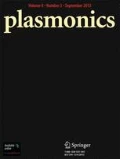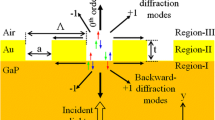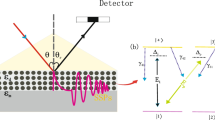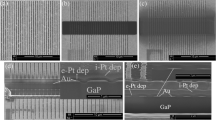Abstract
A method to sense the excitation of surface plasmon polariton (SPP) on metallic grating device using the transmitted signal will be presented. The grating transmittance signal will be fully characterized varying the light incident angle and azimuthal grating orientation by means of the SPP vector model and rigorous coupled-wave analysis simulation. Simulation results will be compared with experimental measurements obtained with a 635 nm wavelength laser in the transverse magnetic polarization mode. The laser will light grating devices in contact with either air or water through a customized microfluidic chamber. A characterization of the diffracted rays will show the relationship between the grating coupling configuration and the Kretschmann one. In fact, the diffracted ray affected by SPP resonance is transmitted with an output angle which is the same incident angle that should be used to excite SPP in Kretschmann configuration. Lastly, the grating parameters (amplitude and metal thickness) impact on transmittance signal will be analyzed with respect to the order zero reflectance signal.











Similar content being viewed by others
References
Raether H (1988) Surface plasmons on smooth and rough surfaces and on gratings. Springer, Berlin
Homola J, Yee SS, Gauglitz G (1999) Surface plasmon resonance sensors: review. Sensors Actuators B Chem 54(1–2):3–15
Miwa S, Arakawa T (1996) Selective gas detection by means of surface plasmon resonance sensors. Thin Solid Films 281–282:466–468
Karlsson R, Stahlberg R (1995) Plasmon resonance detection and multispot sensing for direct monitoring of interactions involving low-molecular-weight analytes and for determination of low affinities. Anal Biochem 228(2):274–280
Lawrence CR, Geddes NJ, Furlong DN (1996) Surface plasmon resonance studies of immunoreactions utilizing disposable diffraction gratings. Biosens Bioelectron 11(4):389–400
Unfricht DW, Colpitts SL, Fernandez SM, Lynes MA (2005) Grating-coupled surface plasmon resonance: a cell and protein microarray platform. Proteomics 5(17):4432–4442
Singh BK, Hillier AC (2008) Surface plasmon resonance enhanced transmission of light through gold-coated diffraction gratings. Anal Chem 80(10):3803–3810
Otto A (1968) Excitation of surface plasma waves in silver by the method of frustrated total reflection. Z Phys 216:398–410
Kretschmann E (1972) Decay of non radiative surface plasmons into light on rough silver films. Comparison of experimental and theoretical results. Opt Commun 6:185–187
Gurel K, Kaplan B, Guner H, Bayindir M, Dana A (2009) Resonant transmission of light through surface plasmon structures. Appl Phys Lett 94(23):233102–233102
Turker B, Guner H, Ayas S, Ekiz OO, Acar H, Guler O, Aykutlu D (2011) Grating coupler integrated photodiodes for plasmon resonance based sensing. Lab Chip 11(2):282–287
Veith M, Miiller KG, Knoll W (1995) Propagation and deflection of guided modes in planar waveguides via grating rotation. Appl Phys B 60(1)
Romanato F, Hong L, Kang H, Wong C, Yun Z, Knoll W (2008) Azimuthal dispersion and energy mode condensation of grating-coupled surface plasmon polaritons. Phys Rev B 77(24):245435
Kim D (2005) Effect of the azimuthal orientation on the performance of grating-coupled surface-plasmon resonance biosensors. Appl Opt 44(16):3218–3223
Fontana E (2004) Theoretical and experimental study of the surface plasmon resonance effect on a recordable compact disk. Appl Opt 43(1):79–87
Romanato F, Lee KH, Kang HK, Ruffato G, Wong CC (2009) Sensitivity enhancement in grating coupled surface plasmon resonance by azimuthal control. Opt Express 17(14):12145–12154
Sonato A, Silvestri D, Ruffato G, Zacco G, Romanato F, Morpurgo M (2013) Quantitative control of poly(ethylene oxide) surface antifouling and biodetection through azimuthally enhanced grating coupled-surface plasmon resonance sensing. Appl Surf Sci 286:22–30
Moharam MG, Grann EB, Pommet DA, Gaylord TK (1995) Formulation for stable and efficient implementation of the rigorous coupled-wave analysis of binary gratings. J Opt Soc Am A 12(5):1068
Moharam MG, Pommet DA, Grann EB (1995) Stable implementation of the rigorous coupled-wave analysis for surface-relief gratings: enhanced transmittance matrix approach. J Opt Soc Am A 12(5):1077–1086
Lalanne P, Morris GM (1996) Highly improved convergence of the coupled-wave method for TM polarization. J Opt Soc Am A 13(4):779–784
Li L, Chandezon J, Granet G, Plumey JP (1999) Rigorous and efficient grating-analysis method made easy for optical engineers. Appl Opt 38:304–313
Chandezon J, Dupuis MT, Cornet G, Maystre D (1982) Multicoated gratings: a differential formalism applicable in the entire optical region. J Opt Soc Am 72(7):839
Park S, Lee G, Song SH, Oh CH, Kim PS (2003) Resonant coupling of surface plasmons to radiation modes by use of dielectric gratings. Opt Lett 28(20):1870–1872
Park S, Won HS, Lee G, Song SH, Oh CH, Kim PS (2005) Grating-assisted emission of surface plasmons. J Korean Phys Soc 46(2):492–497
Yoon J, Song SH, Kim J-H (2008) Extraction efficiency of highly confined surface plasmon-polaritons to far-field radiation: an upper limit. Opt Express 16(2):1269–1279
Byun K, Kim S, Kim D (2007) Grating-coupled transmission-type surface plasmon resonance sensors based on dielectric and metallic gratings. Appl Opt 46(23):5703–5708
Author information
Authors and Affiliations
Corresponding author
Rights and permissions
About this article
Cite this article
Perino, M., Pasqualotto, E., Scaramuzza, M. et al. Characterization of Grating Coupled Surface Plasmon Polaritons Using Diffracted Rays Transmittance. Plasmonics 9, 1103–1111 (2014). https://doi.org/10.1007/s11468-014-9720-5
Received:
Accepted:
Published:
Issue Date:
DOI: https://doi.org/10.1007/s11468-014-9720-5




